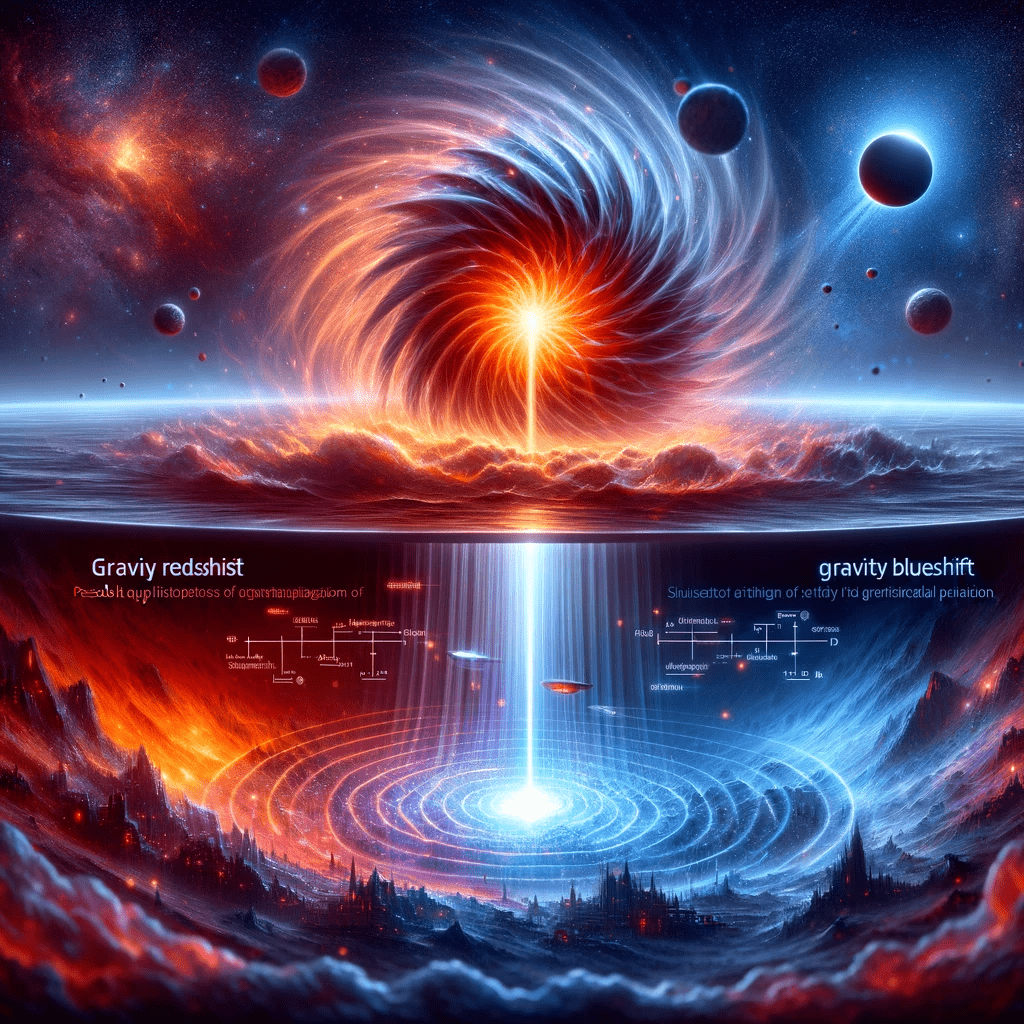Gravity Redshift and Gravity Blueshift

Gravitational redshift and blueshift offer intriguing insights into the nature of light and gravity, deeply rooted in Einstein’s theory of General Relativity. These phenomena, once confirmed in a lab setting, have also been observed in astronomical environments, shedding light on the behavior of massive objects like neutron stars. Interestingly, if unidentified aerial phenomena (UAPs) harnessed this concept, it could lead to groundbreaking applications, ranging from propulsion to stealth.
Gravity redshift and gravity blueshift are relativistic effects related to the propagation of light or other electromagnetic radiation in a gravitational field. These effects arise due to Einstein’s theory of General Relativity.
- Gravity Redshift (Gravitational Redshift):
- Concept: When light or other electromagnetic radiation moves away from a massive object, its wavelength increases (redshifts) because of the gravitational field’s influence.
- Cause: In General Relativity, spacetime is curved in the presence of mass and energy. As light climbs out of a gravitational well, it loses energy. The loss of energy manifests as an increase in the wavelength of the light.
- Gravity Blueshift:
- Concept: The opposite of gravitational redshift. When light or other electromagnetic radiation moves towards a massive object, its wavelength decreases (blueshifts) because of the influence of the gravitational field.
- Cause: As light descends into a gravitational well, it gains energy. This gain in energy manifests as a decrease in the wavelength of the light.
One of the earliest tests confirming gravitational redshift was performed in 1959 at Harvard University by Pound and Rebka. They observed the redshift of gamma rays moving upwards in Earth’s gravitational field. In astrophysical contexts, gravitational redshift is also crucial. For instance, light emitted from the surface of a neutron star or a white dwarf is redshifted due to the extreme gravitational fields of these objects.
The gravitational redshift and blueshift arise because of the curvature of spacetime in the presence of mass and energy, as described by General Relativity. Light changes its frequency as it moves in and out of gravitational wells, leading to a shift in its observed wavelength.
If a UAP had a mechanism to generate a significant gravitational field (similar to the theoretical concept of a “warp drive”), then light passing close to or through this field could be redshifted or blueshifted. Observers might detect these shifts, although it would be challenging to distinguish them from other possible astrophysical or atmospheric sources of redshift and blueshift.
If UAP had the ability to generate a significant gravitational field and subsequently cause gravitational redshift or blueshift, we could speculate on several purposes or reasons:
- Propulsion: A device or mechanism that can create a gravitational field might be used for propulsion. This is akin to the theoretical idea of a “warp drive” where spacetime is compressed in front of the craft and expanded behind it, allowing faster-than-light travel (in terms of the craft’s local frame of reference) without violating the principles of relativity.
- Stealth: If the UAP can produce such effects, then manipulating the wavelength of electromagnetic radiation might act as a sort of cloaking device. By redshifting or blueshifting light or other forms of electromagnetic radiation, the UAP might become invisible or less visible in certain portions of the spectrum.
- Communication: Modulating the gravitational field might be a way to encode and send information. An observer with the appropriate tools and understanding might be able to decipher messages or signals from the redshift/blueshift patterns.
- Environmental Interaction: Generating a gravitational field could have effects on the local environment. This could range from collecting particles in the atmosphere or space for study, refueling, or other purposes, to interacting with other objects or entities in ways that are beneficial for the UAP.
- Sensor Mechanism: By generating a gravitational field and observing how external light or radiation redshifts or blueshifts as it interacts with the field, the UAP might gain information about its surroundings, functioning as a sort of sensor or scanner.
- Defensive Mechanism: By altering the trajectory of electromagnetic waves, it might deflect certain types of sensors or even energy-based weapons, rendering them ineffective or less effective against the UAP.
- Scientific Study: If these UAPs were operated by an advanced civilization, this gravitational field generation might be a part of scientific experiments or studies related to the nature of spacetime, gravity, or light itself.
The interplay between light and gravity provides a captivating perspective on our universe’s workings. From experiments at Harvard confirming gravitational redshift to speculations about UAPs harnessing these principles for varied objectives, the potential applications of such phenomena are vast. Whether it’s theoretical propulsion systems resembling “warp drives” or advanced communication methods, these concepts compel us to reimagine our understanding of physics and what might be possible in the cosmos.

